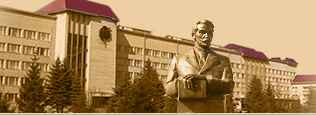DROHOBYCH URBAN SYSTEM: FORMATION AND INTERACTION WITH NATURAL LANDSCAPE BASIS.
In this paper we consider the peculiarities of retrospective landscape structure. The Drohobych urban system had been originated within its limits. It was discovered there was a landscape diversity on three landscape grounds and the characteristics of their spatial combinations were analyzed. We made a landscape map-chart of the current state of Drohobych urban system where monitoring and correcting impact of natural landscape basis is clearly manifested. In this case brief actions and processes are often controlled by anthropogenic factor and durational – by natural one. The current state of Drohobych urban system is characterized by processes of drastic decrease of industrial influence because of its actual retrogression. At the same time the spatial analysis of the urban system gives us an opportunity to claim the tendency to expand due to the absorption of surrounding villages; many of them actually already refer to the Drohobych city. Despite the reduction, and even decline of industrial influence to the urban system there we can observe increasing of traffic flows which creates negative ecological background. This situation requires the establishment of a special urban system monitoring with clearly defined functions. Such monitoring may combine industry monitoring services as structural components while providing for their coordination as well as implementing an emergent systemic effect to achieve the most close to reality analysis and conclusions. The analysis leads to the conclusion that further development and planning of Drohobych urban system must be based on on a clear account of specificity of the natural landscape foundation, its development and evolution, which will ensure avoidance of conflicts between natural and anthropogenic factors.
Key words: urban system, retrospective landscape structure, urban landscapes, urban system monitoring.
References:
- Gerenchuk K.I. Suchasniy stan i zavdannya metodichnych poshukiv v landshaftoznavstvi // Fizychna geografiya ta geomorfologiya. K.: – 1972. is Vyp.. №7. – P. 3-7.
- Golubec‘ M.A. Urbanistychni utvory yak komponent biogeocenotichnogo pokryvu // Antropogenni zminy biogeocenotichnogo pokryvu v Karpats’komu regioni. – Kyiv: Naukova dumka, 1994. – P. 22-34.
- Gosudarstvennyi standart Souza SSSR. Ohrana prirody. Landshafty. Terminy i opredileniya. GOST 17.8.1.01. – 80. Utverzden i vveden v deistvie Postanovleniem Gosudarstvennogo komiteta SSSR po standartam ot 30 Dekabria, 1980 ¹ 6192. Izdanie oficialnoe. – M.: Izd-vo standartov, 1081. – 9 p.
- Dmitruk O.Y. Urbanizovani landshafty: teoretichni ta metodichni osnovy konstruktyvno-geografichnogo doslidzhennya. – K.: VGL Obriy, 2004. – 240 p.
- Koval’ov O. Misto yak urbogeosystema // Suchasni problemy i tendencii rozvytku geografichnoi nauky: mater. mizhnar. konf. do 120-richchya geografii v L’vivs’komu un-ti (24-26 veresnya 2003) – L’viv: Vidav. center LNU imeni Ivana Franka, 2003. – P. 95-98.
- Kucheryaviy V.P. Okul’turenist’ mis’kykh biogeocenoziv // Ekologichna encyklopediya: V 3 t. / Redkolegiya: A.V. Tolstoukhov (golovniy redaktor) ta in. – K.: TOV “Center ekologichnoi osvity ta informacii” T. 3: O-YA. – P. 23-24.
- Petlin V.M. Landshaftno-ekologichna ekspertyza: Navch. posibn. – L’viv: Vidavnichiy center LNU im. Ivana Franka, 2005. – 236 p.
- Petlin V.M. Konstruktyvne landshaftoznavstvo. – L’viv: Vidavnichiy center LNU im. Ivana Franka, 2006. – 357 p.
- Pokshishevskiy V.V. Tipy horodskich i sel’s’kich poseleniy SSSR i teritoriya “horodov-centralnych misc”. // XIX мezdunarodnyi geografichnyi congress, 1961. – P. 240-244.
FULL TEXT:
